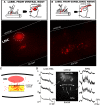Plasticity in Preganglionic and Postganglionic Neurons of the Sympathetic Nervous System during Embryonic Development
- PMID: 37833062
- PMCID: PMC10630925
- DOI: 10.1523/ENEURO.0297-23.2023
Plasticity in Preganglionic and Postganglionic Neurons of the Sympathetic Nervous System during Embryonic Development
Abstract
Sympathetic preganglionic neurons (SPNs) are the final output neurons from the central arm of the autonomic nervous system. Therefore, SPNs represent a crucial component of the sympathetic nervous system for integrating several inputs before driving the postganglionic neurons (PGNs) in the periphery to control end organ function. The mechanisms which establish and regulate baseline sympathetic tone and overall excitability of SPNs and PGNs are poorly understood. The SPNs are also known as the autonomic motoneurons (MNs) as they arise from the same progenitor line as somatic MNs that innervate skeletal muscles. Previously our group has identified a rich repertoire of homeostatic plasticity (HP) mechanisms in somatic MNs of the embryonic chick following in vivo synaptic blockade. Here, using the same model system, we examined whether SPNs exhibit similar homeostatic capabilities to that of somatic MNs. Indeed, we found that after 2-d reduction of excitatory synaptic input, SPNs showed a significant increase in intracellular chloride levels, the mechanism underlying GABAergic synaptic scaling in this system. This form of HP could therefore play a role in the early establishment of a setpoint of excitability in this part of the sympathetic nervous system. Next, we asked whether homeostatic mechanisms are expressed in the synaptic targets of SPNs, the PGNs. In this case we blocked synaptic input to PGNs in vivo (48-h treatment), or acutely ex vivo, however neither treatment induced homeostatic adjustments in PGN excitability. We discuss differences in the homeostatic capacity between the central and peripheral component of the sympathetic nervous system.
Keywords: autonomic nervous system; chick embryo; homeostatic plasticity; sympathetic nervous system; synaptic scaling.
Copyright © 2023 Ratliff et al.
Conflict of interest statement
The authors declare no competing financial interests.
Figures





References
-
- Aye CYL, Lewandowski AJ, Oster J, Upton R, Davis E, Kenworthy Y, Boardman H, Yu GZ, Siepmann T, Adwani S, McCormick K, Sverrisdottir YB, Leeson P (2018) Neonatal autonomic function after pregnancy complications and early cardiovascular development. Pediatr Res 84:85–91. 10.1038/s41390-018-0021-0 - DOI - PMC - PubMed
Publication types
MeSH terms
Grants and funding
LinkOut - more resources
Full Text Sources
Research Materials
Miscellaneous
